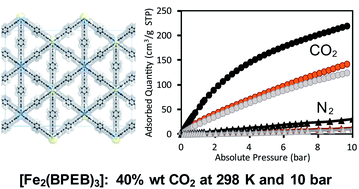When long bis(pyrazolates) meet late transition metals: structure, stability and adsorption of metal–organic frameworks featuring large parallel channels†
Abstract
A family of bis(pyrazolato)-based metal-organic frameworks (MOFs) was isolated by reacting 1,4-bis(1H-pyrazol-4-ylethynyl)benzene (H2BPEB) with a number of transition metal ions. Special attention was dedicated to their structural features, their thermal and chemical stability, as well as their spectroscopic and adsorption properties. The rod-like ligands, connecting Zn(II), Ni(II) and Fe(III) nodes, fabricate 3-D networks containing 1-D pervious channels. The combination of thermal analysis and variable-temperature XRPD demonstrated the remarkable thermal robustness of the three materials, which are stable in air up to at least 410 °C, and showed their structural response to increasing temperature. Specific experiments permitted us to test the chemical stability of the three species toward water as well as moderately acidic and basic solutions, the Ni(II) derivative being stable and hydrophobic in all the conditions assayed. The electronic transitions of both the ligand and the MOFs were investigated by solid-state UV-Vis absorption as well as by steady-state and time-resolved fluorescence analysis, which showed that the high fluorescence of the linker is perturbed in the three MOFs, suggesting high sensitivity to environmental changes. N2 adsorption measurements at 77 K allowed to estimate promising Langmuir specific surface areas, peaking at 2378 m2 g−1 in the case of the Ni(II) derivative. The best CO2 and CH4 uptake performances were achieved with the Fe(III)-based MOF. Indeed, adsorption experiments with CO2 revealed that a considerable amount, up to 40% wt, is adsorbed by the Fe(III) derivative under the mild conditions of 298 K and 10 bar.

- This article is part of the themed collection: 2014 Journal of Materials Chemistry A Hot Articles

 Please wait while we load your content...
Please wait while we load your content...